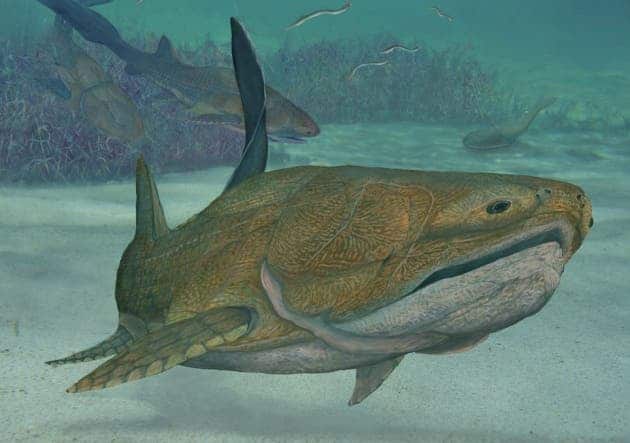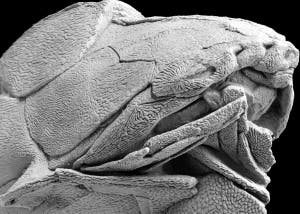
A lot of complex organisms, be them long extinct like dinosaurs or still alive like mammals, present what can only be referred to as a face – a symmetrical arrangement on the head of the animal of eyes, nose and, most importantly, jaw and cheek-bones. Human are particularly adapted to recognizing faces. Thanks to our pattern solving abilities, humans have a keen talent for recognizing faces – an evolutionary treat necessary to distinguish between our peers – even in places that only look like faces (Jesus in a wood stump, human faces on Mars etc.). How did faces evolve and what animal had the first face, though?
Scientists believe the first animal currently known to us to feature what can only be called a face to be a primitive species of fish called entelognathus primordialis (meaning “primordial complete jaw”). The fish has been dated at 419-million-years old and was found at Xiaoxiang Reservoir in Quijing, Yunnann, China. The stunning fossil was remarkably preserved for its age at the moment of discovery, helping the team of international paleontologists to determine a number of physiological characteristics. One of the first things that came to their attention was the fish’s thick exterior armor and facial bones.
“Entelognathus had a rather unprepossessing face,” co-author Per Erik Ahlberg of Uppsala University told Discovery News. “The mouth was wide, the forehead low and flat, and the small, close-set and almost immobile eyes pointed forwards like a pair of car headlights.”
Jaw-dropping find puts evolution of modern face in a new light

Primitive fish older and even contemporary with e. primordialis must have looked very bizarre by today’s face-featuring standards, considering fossil records. According to Matt Friedman, a lecturer in paleobiology at the University of Oxford, these fish must have had “broad, shovel-shaped heads with their eyes placed on top, while others had narrow bodies and skulls with their eyes on either side of the head.” The eel-like lampreys and hagfishes, which are still alive today and which scientists commonly referred them as living fossils, are worthy examples of how these kind of prehistoric animals must have looked like.
Classic textbooks and scientific common knowledge describe the precursors to modern face-bearing animals as looking shark-like. This may be flawed information, according to the authors of the paper. The newly found prehistoric fish “puts a new face” on the original jawed species, Friedman and Brazeua write. Taking this into account, the authors revise the family tree of jawed vertebrates, showing that there is a serious possibility that the modern bony visage originated with e. primordialis’s ancestors. Sharks, it may seem, are actually more evolved organisms that retain aspects from an earlier ancestor – maybe e. primordialis itself. This would mean that humans look more like the last common ancestor of living jawed vertebrates than we thought.
“There has been a long tradition of portraying sharks as especially primitive,” Friedman said. “This is common in textbooks and documentaries that falsely claim that sharks are ‘living fossils’ and have gone unchanged for millions of years.”
It’s still unclear as to why jaw and cheek-bones appeared. A leading theory rather intuitively states that the face evolved as a superior feeding mechanism, allowing for a more flexible and adapted way of chewing on larger prey. Study co-author Brian Choo suspects that jaws might have “evolved initially for breathing, as an apparatus to control the flow of water across the gills.”
The findings appeared in the journal Nature. [story via Discovery]
[NOW READ] Did you know there’s a fish that has human teeth? The sheepshead fish is one of a kind






